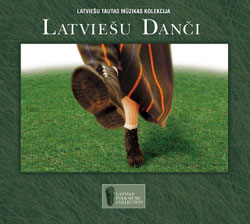
“It makes me feel happy.” A British executive of a prestigious international company said this when he heard the new Latvian Folk Music Collection’s Latviešu danči (Latvian Dances) playing as telephone on-hold music at his company. Overall, that is quite an accurate assessment of this disc.
To put it another way, the music on this album is, in two words, quintessentially Latvian. As ethnomusicologist Valdis Muktupāvels writes in the liner notes (in both Latvian and English, although a few of the English phrases are a bit awkward), Latvians love to dance. This love is truly evident in the joyous music on this disc.
The music was performed by a number of people, including Māris Muktupāvels (producer of this album) and Ilga Reizniece, both of whom are well known and highly respected in Latvian folk music circles. Other notable performers include Gints Sola, guitarist for the pop-rock group Jauns Mēness, and Mikus Čavarts, like Reizniece and Māris Muktupāvels a member of the folklore ensemble Iļģi. One surprise addition is Ilmārs Mežs and his family. Mežs, known in part for his research into Latvian demographics, also is lead singer for the folklore ensemble Eilenders.
Included in the liner notes are instructions (in Latvian only), written by Sniedze Grīnberga, for dancing the dances. It’s a wonderful idea, but does not work all that well. The directions particularly would not work well for two groups of people (other than those who do not read Latvian): those who are highly visually oriented and those who have no Latvian dance knowledge or experience. These people might be able to figure out only the simplest dances. I am quite visually oriented when it comes to dancing, never having been a big fan of written dance instructions with no illustrations because I have a very difficult time picturing the steps and formations. As for the dances on this disc, I was able to follow along the instructions mostly only to the dances that I have danced before.
However, on a purely musical level, this is absolutely fantastic music. The second track, “Cūkas driķos” is one of the more rousing versions I’ve heard and I had an almost irrepressible urge to begin dancing down the hallways of my office when I heard it. The tracks with vocals make you want to sing along at the top of your voice. The 15 dances chosen for inclusion on this disc offer a nice variety: some are fast, others are slower, some have vocals, others are instrumental. Most Latvians will be familiar with at least a couple of dances, such as “Tūdaliņ, tagadiņ” and “Mugurdancis,” which are classics that children learn at very young ages. Yet there also are tracks that will be new to many listeners.
Another enjoyable aspect of this disc is that dancers were a part of the recording. Not only does the listener hear the wonderful music, but also the actual dancing. In other words, it is very much a live recording. For those of us living outside of Latvia, at times this disc is as close as many of us will come to an authentic evening of Latvian dancing, singing and merrymaking.
This disc will make Latvians feel Latvian to the depths of their souls (and to tips of their toes) and it will give non-Latvians a greater appreciation of Latvian culture. Naturally, this is the somewhat biased opinion of a former dancer who is crazy about both Latvian dance and music, but if a half dozen co-workers from around the world at my office enjoyed Latviešu danči, I am certain all readers will as well.
Details
Latviešu danči
Latviešu tautas mūzikas kolekcija
UPE Recording Co., 1999
UPE CD 011
© 1995-2025 Latvians Online
Please contact us for editorial queries, or for permission to republish material. Disclaimer: The content of Web sites to which Latvians Online provides links does not necessarily reflect the opinion of Latvians Online, its staff or its sponsors.





That’s exacly the kind of (dance) music I’m always looking for: Traditional music of a country or an area played from and for the people living there. I danced Latvian dances, I know their relatives, and I can read dance instructions. But I have no chance to understand Latvian texts, so it’s really pity to me that the track notes are in Latvian only. E.g. Track 8 is a dance called “Kreuzpolka” and the tune is well-known along the baltic sea, in Germany it is called “Siehst du wohl da kimmt er, große Schritte nimmt er”.